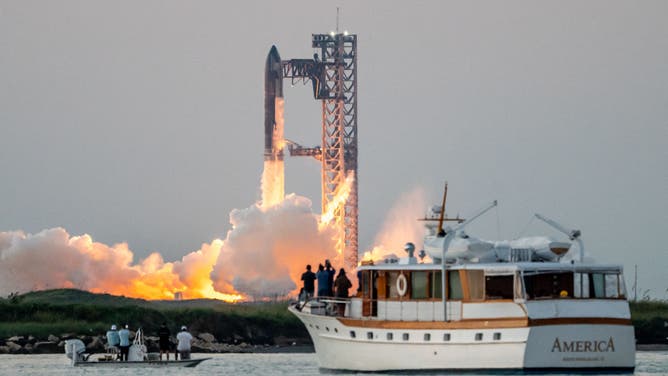Study captures the real rumble of SpaceX Starship heard from 20 miles away
A BYU research team set up eight acoustic measurement stations around SpaceX’s Starbase facility in Texas to find out just how loud the world’s most powerful rocket really is. Starship's launch was still as loud as a rock concert from 6 miles away.
SpaceX catches Starship booster in successful fifth test flight
Highlights from SpaceX's fifth orbital test flight of the Starship spaceship show the launch, separation and the first successful catch of the Super Heavy Booster in Texas on Oct. 13, 2024.
A team of researchers is looking to determine how much impact the roar of SpaceX Starship and Super Heavy booster can have on surrounding communities, including wildlife.
SpaceX has completed five test flights of its 400-foot-tall Starship and Super Heavy booster launch system, from its launch facilities in South Texas. The spaceship is the world's largest and most powerful rocket – and, as expected, a very loud launch to experience even from miles away.
BYU’s Physics and Aerospace Student-Centered Acoustics Laboratory (PASCAL) team set up eight acoustic measurement stations around SpaceX’s Starbase facility to find out just how loud the world’s most powerful rocket really is.
During these test flights, Starship launches from Texas, enters low-Earth orbit and then splashes down in the Indian Ocean. The Super Heavy booster is designed to land back at the launch tower and be caught by two chopstick-like arms.
SPACEX CATCHES STARSHIP BOOSTER IN 'MECHAZILLA ARMS' IN HISTORIC FIRST
BYU’s initial findings, published this week, show that thundering sonic booms about 30 seconds after the booster return were heard at all eight measuring stations, even as far as North Brownsville, Texas, about 20 miles from SpaceX’s Starbase site. According to a BYU news release, the sound at that distance was about as loud as a vacuum cleaner.

The SpaceX Starship lifts off from Starbase near Boca Chica, Texas, on October 13, 2024, for the Starship Flight 5 test. SpaceX successfully "caught" the first-stage booster of its Starship megarocket Sunday as it returned to the launch pad after a test flight, a world first in the company's quest for rapid reusability. (Photo by SERGIO FLORES / AFP) (Photo by SERGIO FLORES/AFP via Getty Images)
(Getty Images)
The study authors wrote that it was "surprising the maximum noise during the landing burn … is on par with the maximum liftoff noise." For liftoff, the booster fires all 33 engines, while landing requires only 13.
The Starship launch sound was loud by any standards: even 10 kilometers (6.2 miles) away, it was as loud as a rock concert. At 20 kilometers (12.4 miles), it rivaled the noise of a table saw or snowblower. At 30-35 kilometers (18.6-21.7 miles), the sound was still as loud as a vacuum cleaner or hair dryer, according to BYU.
How does Starship's launch noise compare to NASA's Moon rocket, the SLS?
Until Starship's first successful orbital launch, NASA's Moon rocket, the Space Launch System (SLS), was the most powerful. The researchers found that a Starship is louder than the SLS launch by a factor of four to six and the equivalent of at least 10 launches of SpaceX's smaller Falcon 9 rocket.
NASA's Artemis I moon rocket successfully launches
The Artemis I moon rocket successfully launched early Wednesday, starting the Orion spacecraft's journey to orbit the moon and marking a major step toward returning humans to the moon.
While noise is a factor in the environmental studies ahead of SpaceX's first Starship launches from Texas and eventually Florida, this is the first true measure of how far this acoustic impact travels.
The noise is notable because SpaceX plans to replace its current fleet of Falcon 9 and Falcon Heavy rockets with Starship, which will launch about 100 times a year. Florida's Space Coast residents are used to the rumble of frequent – mostly SpaceX launches – but if Starship begins launching there as planned, this will be a much more noticeable disruption.
The study's lead author, BYU physics professor Kent Gee, said these disruptions could impact humans and wildlife. Imagine being woken by a snowblower outside your window nightly.
"We are a space-going people now and it’s a delicate balance. How do you balance that with making sure you’re being a good environmental steward? Our research will see what the impacts are on threatened or endangered species in the region, as well as the impact on community life," Gee said in a statement.
The researchers will also be at Starship’s upcoming sixth test flight from Texas as soon as Tuesday.

